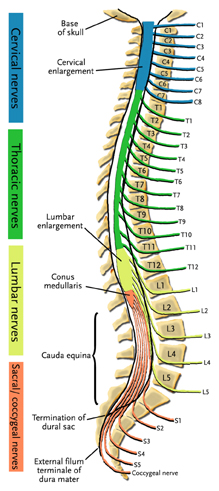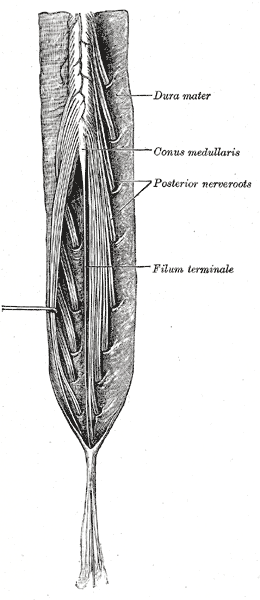Cauda Equina Syndrome: Difference between revisions
No edit summary |
No edit summary |
||
| Line 18: | Line 18: | ||
== Clinical Presentation == | == Clinical Presentation == | ||
Since the cauda equina nerve roots supply most of the lower extremity (including the pelvic region) sensory and motor innervations, cauda equina syndrome results in multiple motor and sensory signs.<sup>1</sup><br> | |||
The most common signs and symptoms include bilateral sciatica, saddle region anesthesia, loss of bowel and bladder control, bilateral foot weakness, quadriceps weakness, severe back pain.<sup>3</sup> Other signs and symptoms include decreased sensation between the legs, buttocks, or feet. <sup>2</sup> | |||
== Diagnostic Procedures == | == Diagnostic Procedures == | ||
Revision as of 21:39, 3 June 2009
Original Editor - Laurie Fiegle and Tabitha Korona
Lead Editors - Your name will be added here if you are a lead editor on this page. Read more.Clinically Relevant Anatomy
[edit | edit source]
add text here relating to clinically relevant anatomy of the condition
Mechanism of Injury / Pathological Process
[edit | edit source]
Cauda equina syndrome can be caused by a number of etiologies but the most common include compressive etiologies such as a herniated lumbosacral disc, spinal stenosis, and spinal neoplasm. Non-compressive causes include ishemia, infection, and inflammatory conditions. 1
Ruptured disc, tumor, or fracture can also lead to Cauda equina syndrome. 2
Clinical Presentation[edit | edit source]
Since the cauda equina nerve roots supply most of the lower extremity (including the pelvic region) sensory and motor innervations, cauda equina syndrome results in multiple motor and sensory signs.1
The most common signs and symptoms include bilateral sciatica, saddle region anesthesia, loss of bowel and bladder control, bilateral foot weakness, quadriceps weakness, severe back pain.3 Other signs and symptoms include decreased sensation between the legs, buttocks, or feet. 2
Diagnostic Procedures[edit | edit source]
add text here relating to diagnostic tests for the condition
Outcome Measures[edit | edit source]
add links to outcome measures here (see Outcome Measures Database)
Management / Interventions
[edit | edit source]
add text here relating to management approaches to the condition
Differential Diagnosis
[edit | edit source]
add text here relating to the differential diagnosis of this condition
Key Evidence[edit | edit source]
add text here relating to key evidence with regards to any of the above headings
Resources
[edit | edit source]
add appropriate resources here
Case Studies[edit | edit source]
add links to case studies here (case studies should be added on new pages using the case study template)
Recent Related Research (from Pubmed)[edit | edit source]
Extension:RSS -- Error: Not a valid URL: Feed goes here!!|charset=UTF-8|short|max=10
References[edit | edit source]
References will automatically be added here, see adding references tutorial.








